Evidence Based Nursing Research: Critical Appraisal of Hand Hygiene
VerifiedAdded on 2023/06/04
|10
|2256
|51
Report
AI Summary
This report provides a critical appraisal of a research article focusing on the impact of the Hand Hygiene New Zealand (HHNZ) program on hand hygiene practices in public hospitals. The report details the study's methodology, including stakeholder involvement, process and outcome measures, and data collection methods. It discusses ethical considerations and highlights significant results, such as improvements in hand hygiene compliance. The report also examines the strengths and limitations of the study, including factors contributing to the program's success and challenges faced during implementation. Recommendations for future improvements, such as enhanced education for frontline workers and improved communication techniques, are also provided. Desklib offers this report and other solved assignments to aid students in their studies.
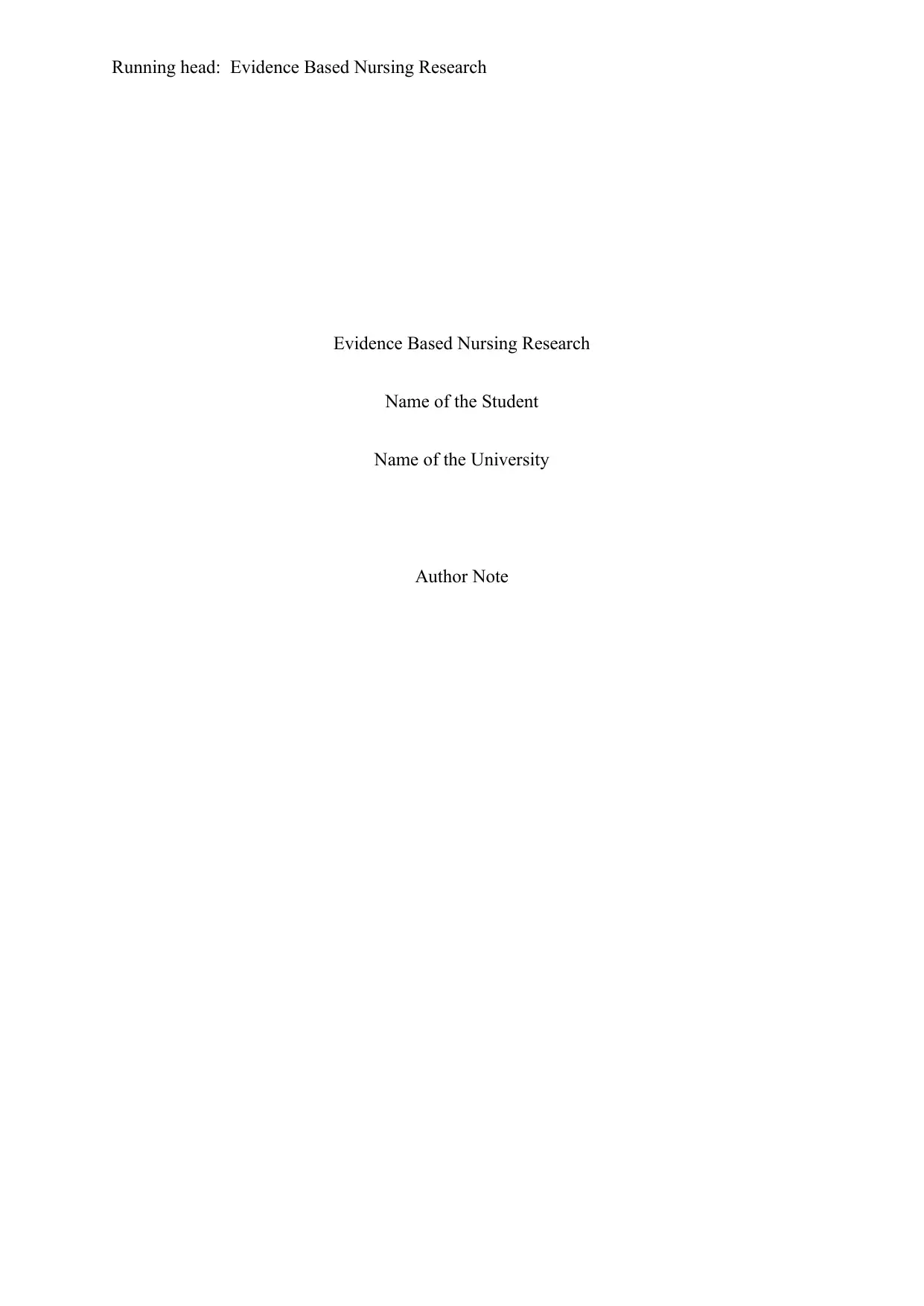
Running head: Evidence Based Nursing Research
Evidence Based Nursing Research
Name of the Student
Name of the University
Author Note
Evidence Based Nursing Research
Name of the Student
Name of the University
Author Note
Paraphrase This Document
Need a fresh take? Get an instant paraphrase of this document with our AI Paraphraser
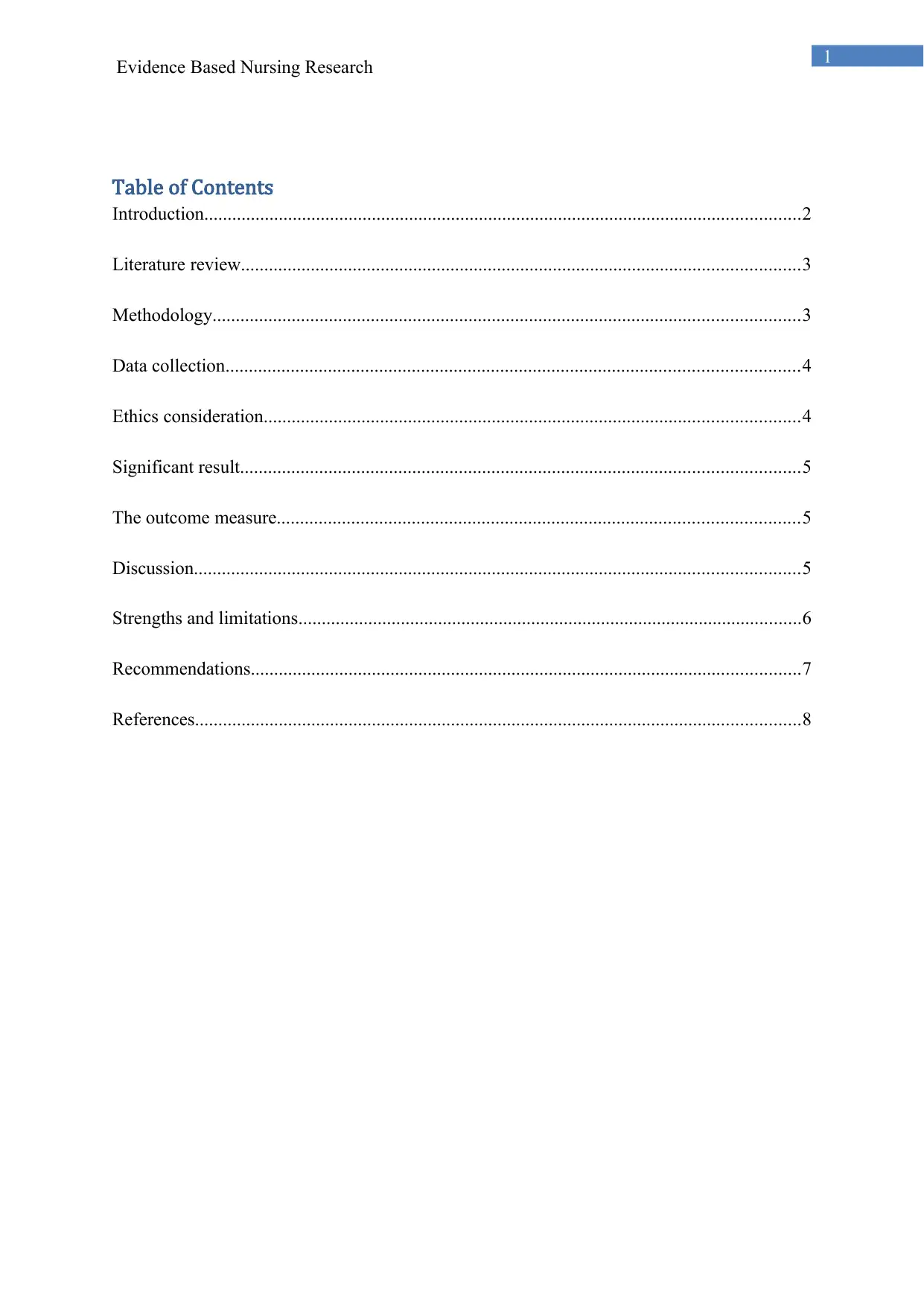
1
Evidence Based Nursing Research
Table of Contents
Introduction................................................................................................................................2
Literature review........................................................................................................................3
Methodology..............................................................................................................................3
Data collection...........................................................................................................................4
Ethics consideration...................................................................................................................4
Significant result........................................................................................................................5
The outcome measure................................................................................................................5
Discussion..................................................................................................................................5
Strengths and limitations............................................................................................................6
Recommendations......................................................................................................................7
References..................................................................................................................................8
Evidence Based Nursing Research
Table of Contents
Introduction................................................................................................................................2
Literature review........................................................................................................................3
Methodology..............................................................................................................................3
Data collection...........................................................................................................................4
Ethics consideration...................................................................................................................4
Significant result........................................................................................................................5
The outcome measure................................................................................................................5
Discussion..................................................................................................................................5
Strengths and limitations............................................................................................................6
Recommendations......................................................................................................................7
References..................................................................................................................................8
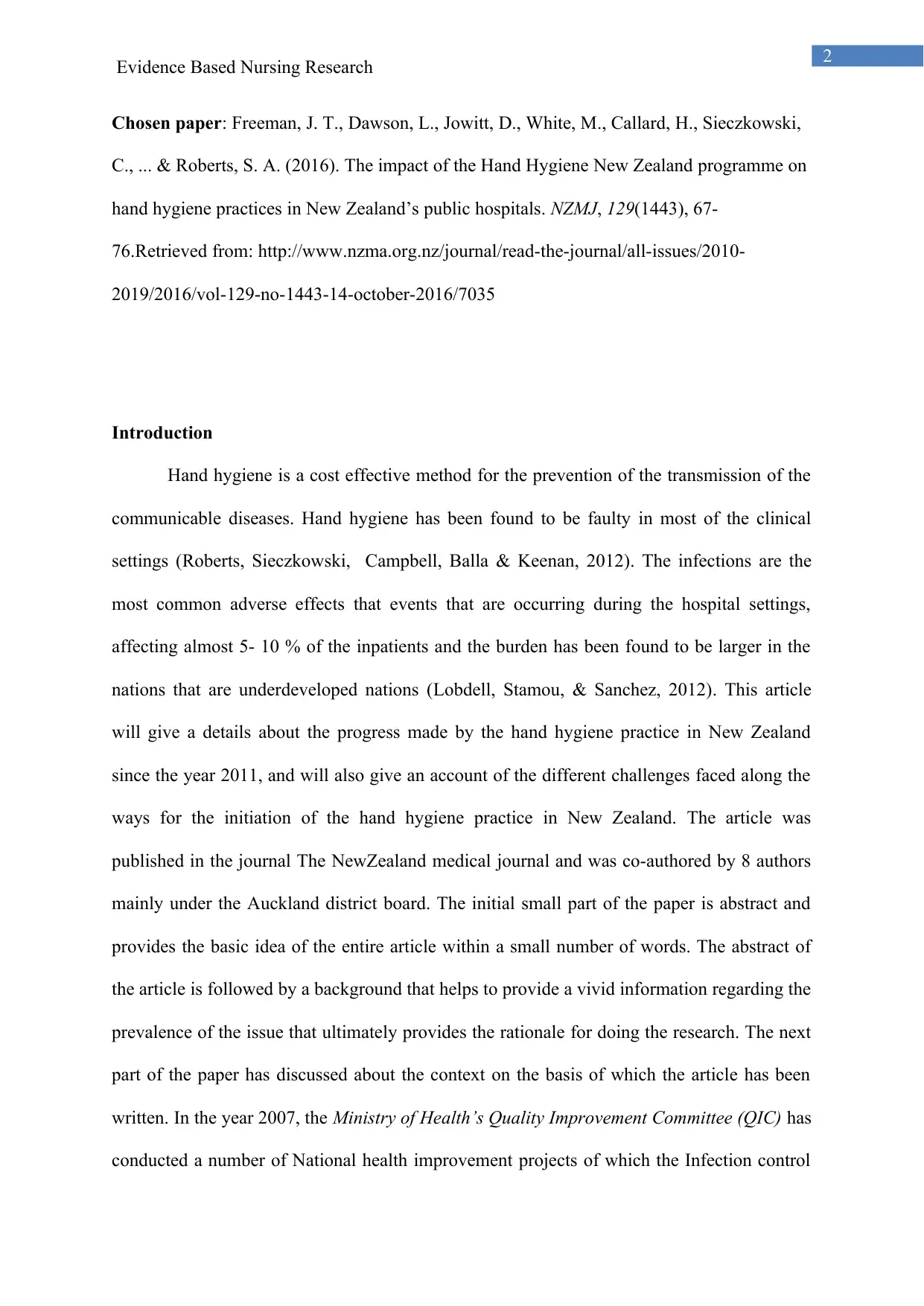
2
Evidence Based Nursing Research
Chosen paper: Freeman, J. T., Dawson, L., Jowitt, D., White, M., Callard, H., Sieczkowski,
C., ... & Roberts, S. A. (2016). The impact of the Hand Hygiene New Zealand programme on
hand hygiene practices in New Zealand’s public hospitals. NZMJ, 129(1443), 67-
76.Retrieved from: http://www.nzma.org.nz/journal/read-the-journal/all-issues/2010-
2019/2016/vol-129-no-1443-14-october-2016/7035
Introduction
Hand hygiene is a cost effective method for the prevention of the transmission of the
communicable diseases. Hand hygiene has been found to be faulty in most of the clinical
settings (Roberts, Sieczkowski, Campbell, Balla & Keenan, 2012). The infections are the
most common adverse effects that events that are occurring during the hospital settings,
affecting almost 5- 10 % of the inpatients and the burden has been found to be larger in the
nations that are underdeveloped nations (Lobdell, Stamou, & Sanchez, 2012). This article
will give a details about the progress made by the hand hygiene practice in New Zealand
since the year 2011, and will also give an account of the different challenges faced along the
ways for the initiation of the hand hygiene practice in New Zealand. The article was
published in the journal The NewZealand medical journal and was co-authored by 8 authors
mainly under the Auckland district board. The initial small part of the paper is abstract and
provides the basic idea of the entire article within a small number of words. The abstract of
the article is followed by a background that helps to provide a vivid information regarding the
prevalence of the issue that ultimately provides the rationale for doing the research. The next
part of the paper has discussed about the context on the basis of which the article has been
written. In the year 2007, the Ministry of Health’s Quality Improvement Committee (QIC) has
conducted a number of National health improvement projects of which the Infection control
Evidence Based Nursing Research
Chosen paper: Freeman, J. T., Dawson, L., Jowitt, D., White, M., Callard, H., Sieczkowski,
C., ... & Roberts, S. A. (2016). The impact of the Hand Hygiene New Zealand programme on
hand hygiene practices in New Zealand’s public hospitals. NZMJ, 129(1443), 67-
76.Retrieved from: http://www.nzma.org.nz/journal/read-the-journal/all-issues/2010-
2019/2016/vol-129-no-1443-14-october-2016/7035
Introduction
Hand hygiene is a cost effective method for the prevention of the transmission of the
communicable diseases. Hand hygiene has been found to be faulty in most of the clinical
settings (Roberts, Sieczkowski, Campbell, Balla & Keenan, 2012). The infections are the
most common adverse effects that events that are occurring during the hospital settings,
affecting almost 5- 10 % of the inpatients and the burden has been found to be larger in the
nations that are underdeveloped nations (Lobdell, Stamou, & Sanchez, 2012). This article
will give a details about the progress made by the hand hygiene practice in New Zealand
since the year 2011, and will also give an account of the different challenges faced along the
ways for the initiation of the hand hygiene practice in New Zealand. The article was
published in the journal The NewZealand medical journal and was co-authored by 8 authors
mainly under the Auckland district board. The initial small part of the paper is abstract and
provides the basic idea of the entire article within a small number of words. The abstract of
the article is followed by a background that helps to provide a vivid information regarding the
prevalence of the issue that ultimately provides the rationale for doing the research. The next
part of the paper has discussed about the context on the basis of which the article has been
written. In the year 2007, the Ministry of Health’s Quality Improvement Committee (QIC) has
conducted a number of National health improvement projects of which the Infection control
⊘ This is a preview!⊘
Do you want full access?
Subscribe today to unlock all pages.

Trusted by 1+ million students worldwide
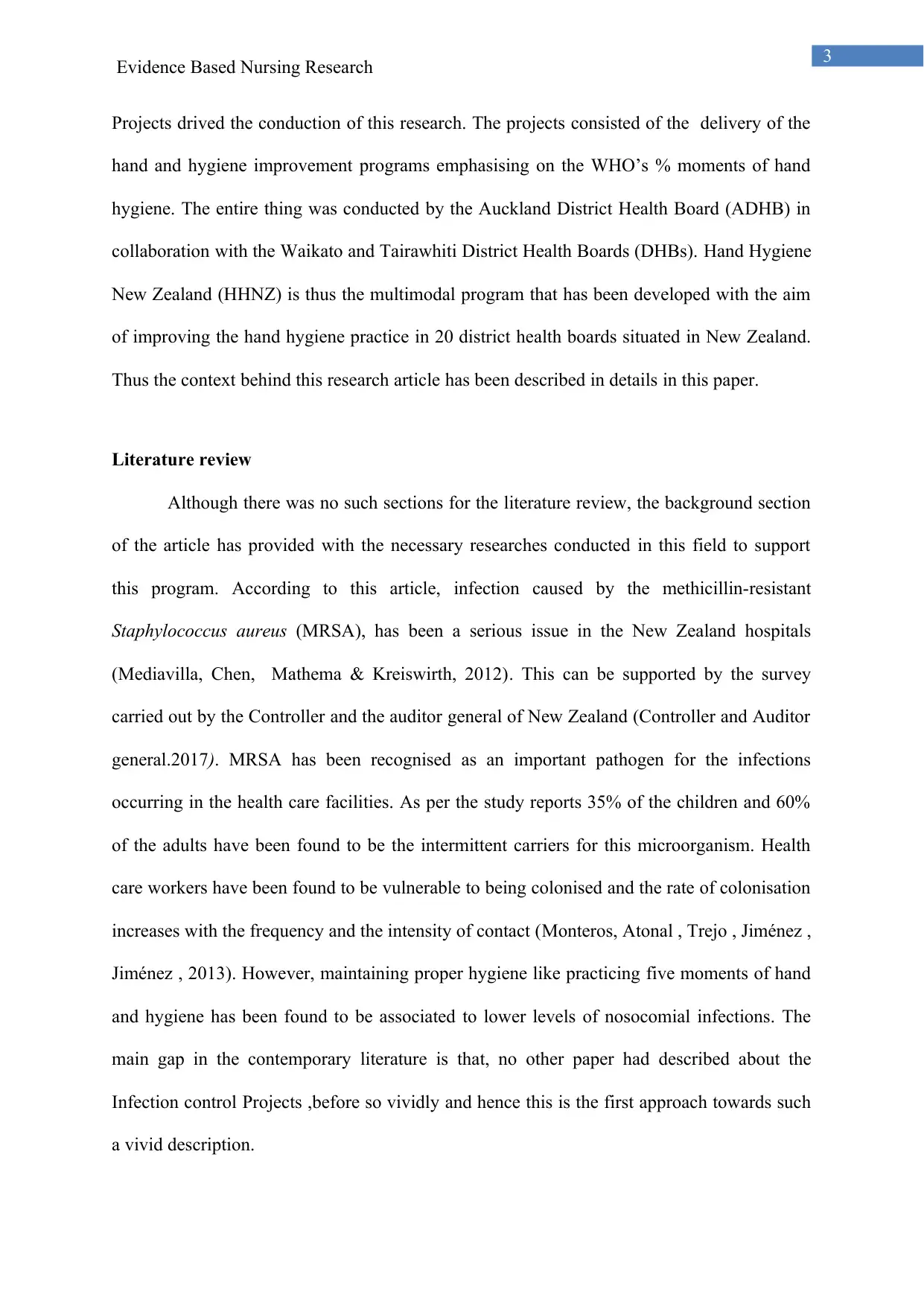
3
Evidence Based Nursing Research
Projects drived the conduction of this research. The projects consisted of the delivery of the
hand and hygiene improvement programs emphasising on the WHO’s % moments of hand
hygiene. The entire thing was conducted by the Auckland District Health Board (ADHB) in
collaboration with the Waikato and Tairawhiti District Health Boards (DHBs). Hand Hygiene
New Zealand (HHNZ) is thus the multimodal program that has been developed with the aim
of improving the hand hygiene practice in 20 district health boards situated in New Zealand.
Thus the context behind this research article has been described in details in this paper.
Literature review
Although there was no such sections for the literature review, the background section
of the article has provided with the necessary researches conducted in this field to support
this program. According to this article, infection caused by the methicillin-resistant
Staphylococcus aureus (MRSA), has been a serious issue in the New Zealand hospitals
(Mediavilla, Chen, Mathema & Kreiswirth, 2012). This can be supported by the survey
carried out by the Controller and the auditor general of New Zealand (Controller and Auditor
general.2017). MRSA has been recognised as an important pathogen for the infections
occurring in the health care facilities. As per the study reports 35% of the children and 60%
of the adults have been found to be the intermittent carriers for this microorganism. Health
care workers have been found to be vulnerable to being colonised and the rate of colonisation
increases with the frequency and the intensity of contact (Monteros, Atonal , Trejo , Jiménez ,
Jiménez , 2013). However, maintaining proper hygiene like practicing five moments of hand
and hygiene has been found to be associated to lower levels of nosocomial infections. The
main gap in the contemporary literature is that, no other paper had described about the
Infection control Projects ,before so vividly and hence this is the first approach towards such
a vivid description.
Evidence Based Nursing Research
Projects drived the conduction of this research. The projects consisted of the delivery of the
hand and hygiene improvement programs emphasising on the WHO’s % moments of hand
hygiene. The entire thing was conducted by the Auckland District Health Board (ADHB) in
collaboration with the Waikato and Tairawhiti District Health Boards (DHBs). Hand Hygiene
New Zealand (HHNZ) is thus the multimodal program that has been developed with the aim
of improving the hand hygiene practice in 20 district health boards situated in New Zealand.
Thus the context behind this research article has been described in details in this paper.
Literature review
Although there was no such sections for the literature review, the background section
of the article has provided with the necessary researches conducted in this field to support
this program. According to this article, infection caused by the methicillin-resistant
Staphylococcus aureus (MRSA), has been a serious issue in the New Zealand hospitals
(Mediavilla, Chen, Mathema & Kreiswirth, 2012). This can be supported by the survey
carried out by the Controller and the auditor general of New Zealand (Controller and Auditor
general.2017). MRSA has been recognised as an important pathogen for the infections
occurring in the health care facilities. As per the study reports 35% of the children and 60%
of the adults have been found to be the intermittent carriers for this microorganism. Health
care workers have been found to be vulnerable to being colonised and the rate of colonisation
increases with the frequency and the intensity of contact (Monteros, Atonal , Trejo , Jiménez ,
Jiménez , 2013). However, maintaining proper hygiene like practicing five moments of hand
and hygiene has been found to be associated to lower levels of nosocomial infections. The
main gap in the contemporary literature is that, no other paper had described about the
Infection control Projects ,before so vividly and hence this is the first approach towards such
a vivid description.
Paraphrase This Document
Need a fresh take? Get an instant paraphrase of this document with our AI Paraphraser
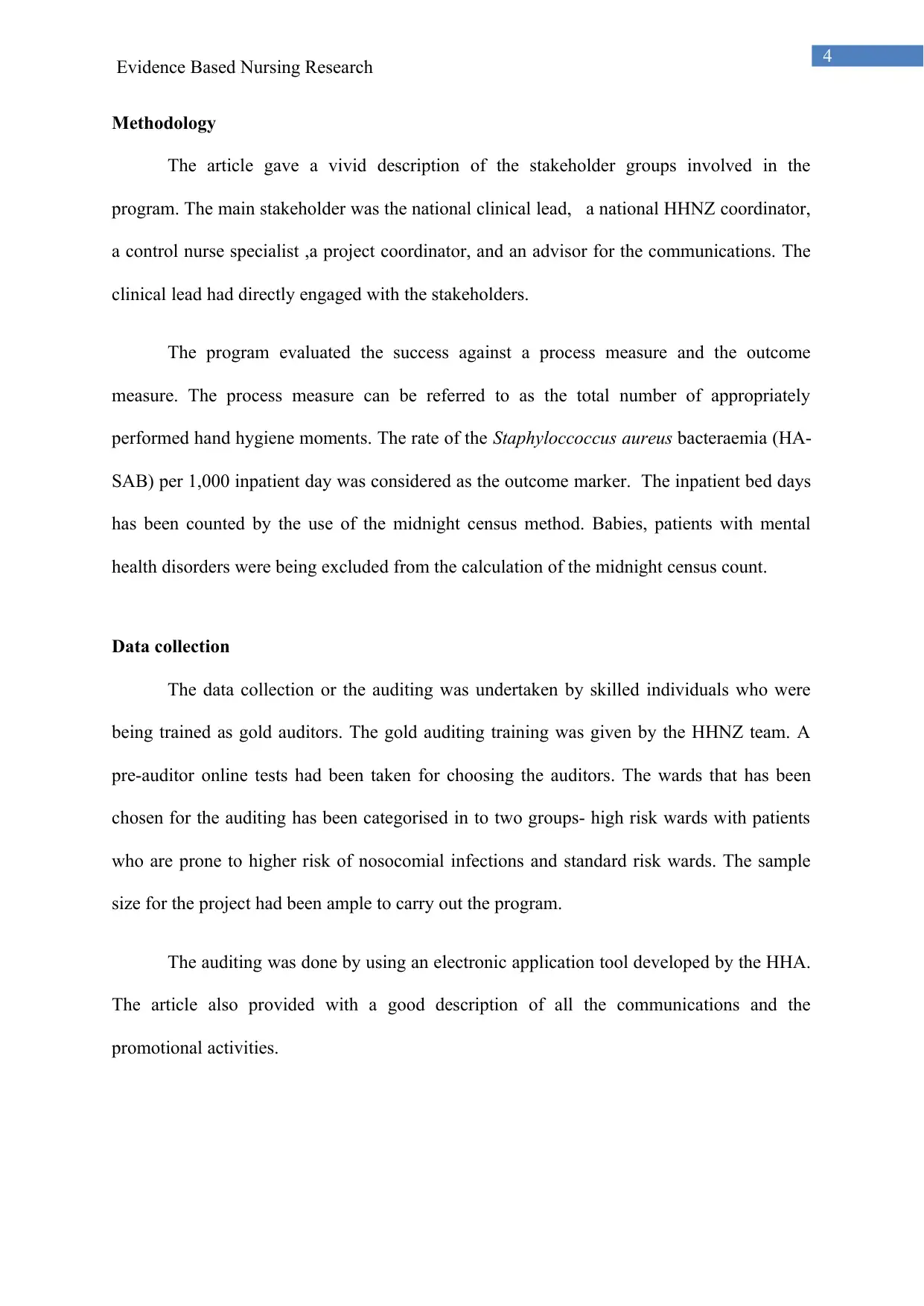
4
Evidence Based Nursing Research
Methodology
The article gave a vivid description of the stakeholder groups involved in the
program. The main stakeholder was the national clinical lead, a national HHNZ coordinator,
a control nurse specialist ,a project coordinator, and an advisor for the communications. The
clinical lead had directly engaged with the stakeholders.
The program evaluated the success against a process measure and the outcome
measure. The process measure can be referred to as the total number of appropriately
performed hand hygiene moments. The rate of the Staphyloccoccus aureus bacteraemia (HA-
SAB) per 1,000 inpatient day was considered as the outcome marker. The inpatient bed days
has been counted by the use of the midnight census method. Babies, patients with mental
health disorders were being excluded from the calculation of the midnight census count.
Data collection
The data collection or the auditing was undertaken by skilled individuals who were
being trained as gold auditors. The gold auditing training was given by the HHNZ team. A
pre-auditor online tests had been taken for choosing the auditors. The wards that has been
chosen for the auditing has been categorised in to two groups- high risk wards with patients
who are prone to higher risk of nosocomial infections and standard risk wards. The sample
size for the project had been ample to carry out the program.
The auditing was done by using an electronic application tool developed by the HHA.
The article also provided with a good description of all the communications and the
promotional activities.
Evidence Based Nursing Research
Methodology
The article gave a vivid description of the stakeholder groups involved in the
program. The main stakeholder was the national clinical lead, a national HHNZ coordinator,
a control nurse specialist ,a project coordinator, and an advisor for the communications. The
clinical lead had directly engaged with the stakeholders.
The program evaluated the success against a process measure and the outcome
measure. The process measure can be referred to as the total number of appropriately
performed hand hygiene moments. The rate of the Staphyloccoccus aureus bacteraemia (HA-
SAB) per 1,000 inpatient day was considered as the outcome marker. The inpatient bed days
has been counted by the use of the midnight census method. Babies, patients with mental
health disorders were being excluded from the calculation of the midnight census count.
Data collection
The data collection or the auditing was undertaken by skilled individuals who were
being trained as gold auditors. The gold auditing training was given by the HHNZ team. A
pre-auditor online tests had been taken for choosing the auditors. The wards that has been
chosen for the auditing has been categorised in to two groups- high risk wards with patients
who are prone to higher risk of nosocomial infections and standard risk wards. The sample
size for the project had been ample to carry out the program.
The auditing was done by using an electronic application tool developed by the HHA.
The article also provided with a good description of all the communications and the
promotional activities.
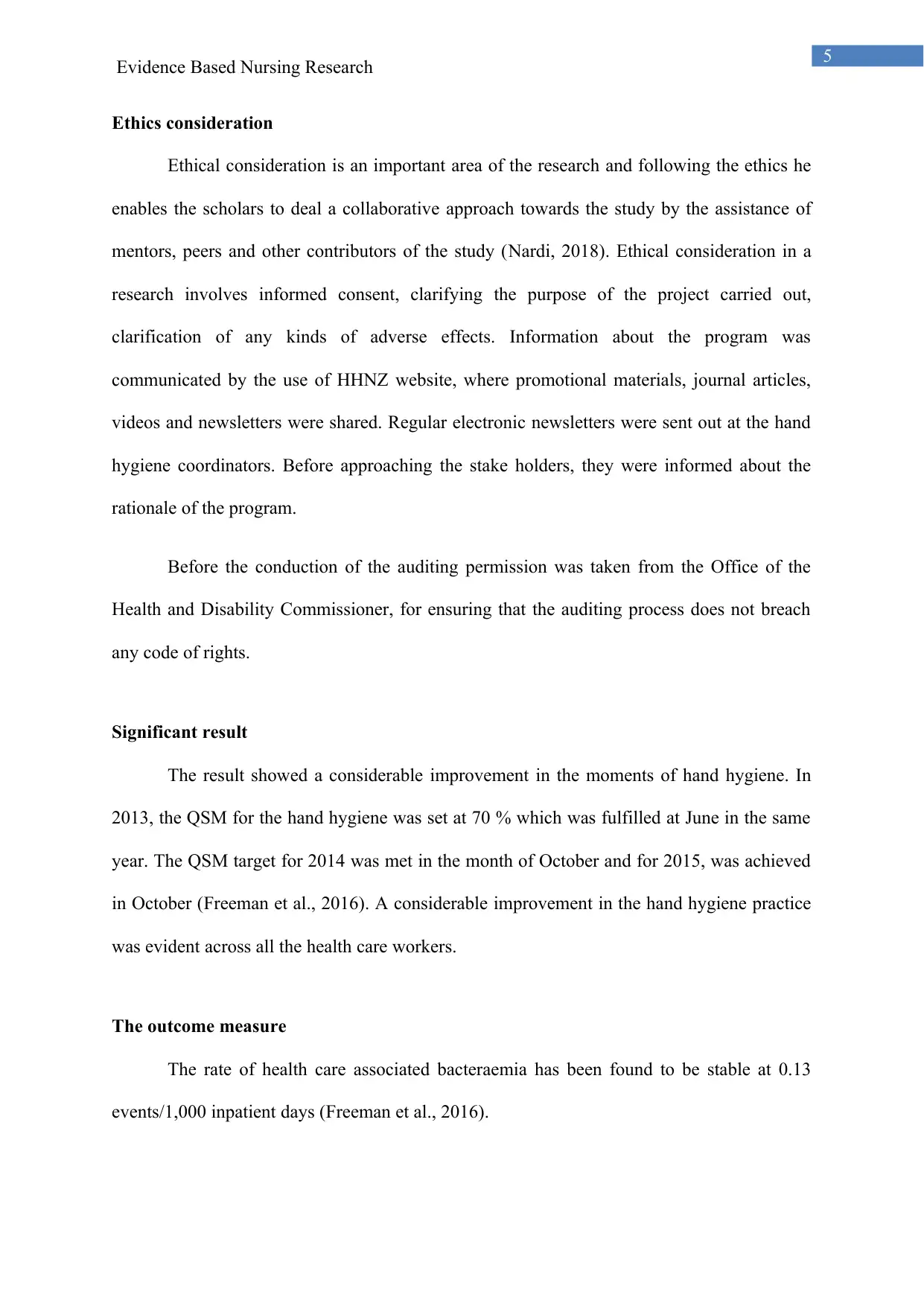
5
Evidence Based Nursing Research
Ethics consideration
Ethical consideration is an important area of the research and following the ethics he
enables the scholars to deal a collaborative approach towards the study by the assistance of
mentors, peers and other contributors of the study (Nardi, 2018). Ethical consideration in a
research involves informed consent, clarifying the purpose of the project carried out,
clarification of any kinds of adverse effects. Information about the program was
communicated by the use of HHNZ website, where promotional materials, journal articles,
videos and newsletters were shared. Regular electronic newsletters were sent out at the hand
hygiene coordinators. Before approaching the stake holders, they were informed about the
rationale of the program.
Before the conduction of the auditing permission was taken from the Office of the
Health and Disability Commissioner, for ensuring that the auditing process does not breach
any code of rights.
Significant result
The result showed a considerable improvement in the moments of hand hygiene. In
2013, the QSM for the hand hygiene was set at 70 % which was fulfilled at June in the same
year. The QSM target for 2014 was met in the month of October and for 2015, was achieved
in October (Freeman et al., 2016). A considerable improvement in the hand hygiene practice
was evident across all the health care workers.
The outcome measure
The rate of health care associated bacteraemia has been found to be stable at 0.13
events/1,000 inpatient days (Freeman et al., 2016).
Evidence Based Nursing Research
Ethics consideration
Ethical consideration is an important area of the research and following the ethics he
enables the scholars to deal a collaborative approach towards the study by the assistance of
mentors, peers and other contributors of the study (Nardi, 2018). Ethical consideration in a
research involves informed consent, clarifying the purpose of the project carried out,
clarification of any kinds of adverse effects. Information about the program was
communicated by the use of HHNZ website, where promotional materials, journal articles,
videos and newsletters were shared. Regular electronic newsletters were sent out at the hand
hygiene coordinators. Before approaching the stake holders, they were informed about the
rationale of the program.
Before the conduction of the auditing permission was taken from the Office of the
Health and Disability Commissioner, for ensuring that the auditing process does not breach
any code of rights.
Significant result
The result showed a considerable improvement in the moments of hand hygiene. In
2013, the QSM for the hand hygiene was set at 70 % which was fulfilled at June in the same
year. The QSM target for 2014 was met in the month of October and for 2015, was achieved
in October (Freeman et al., 2016). A considerable improvement in the hand hygiene practice
was evident across all the health care workers.
The outcome measure
The rate of health care associated bacteraemia has been found to be stable at 0.13
events/1,000 inpatient days (Freeman et al., 2016).
⊘ This is a preview!⊘
Do you want full access?
Subscribe today to unlock all pages.

Trusted by 1+ million students worldwide
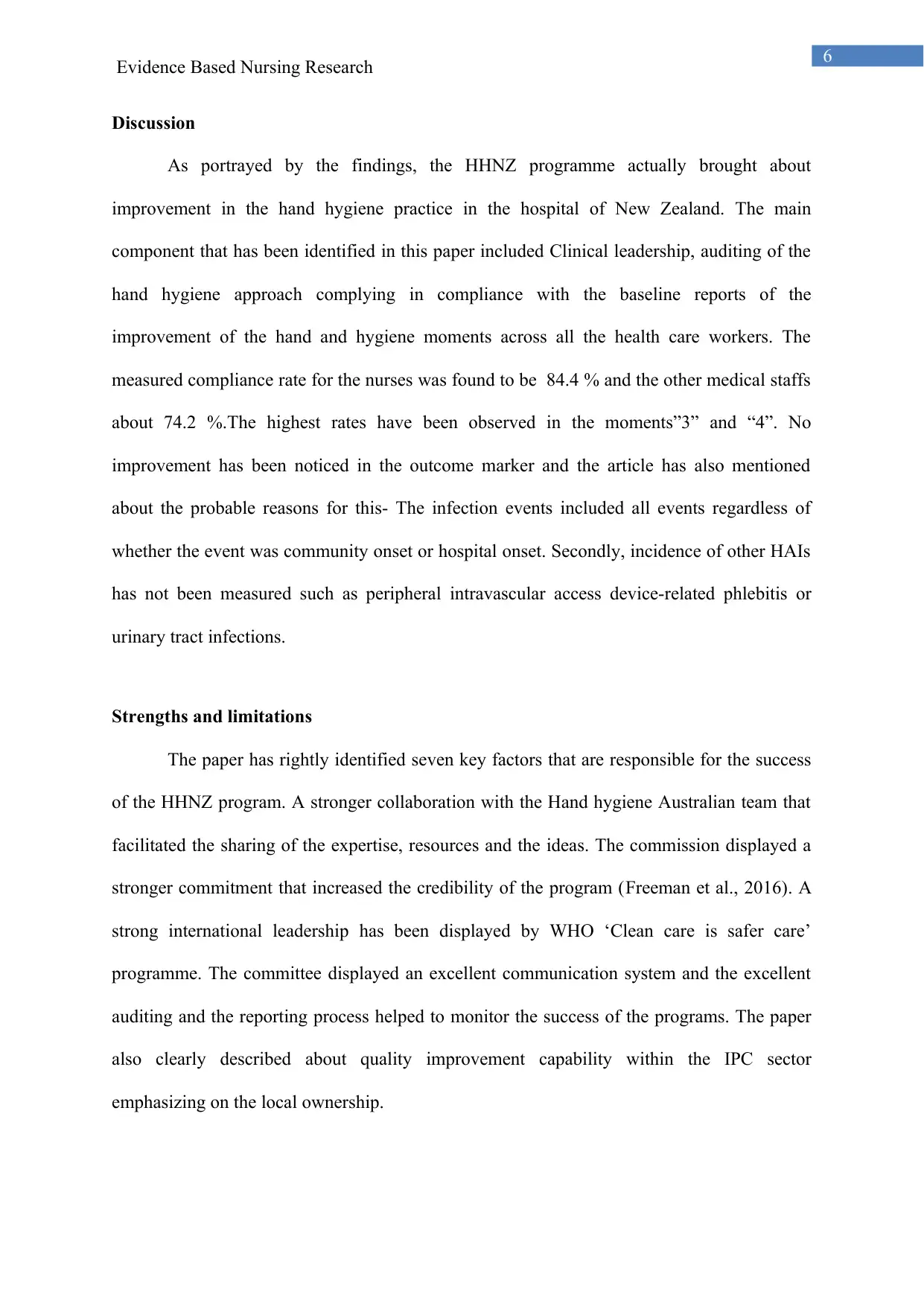
6
Evidence Based Nursing Research
Discussion
As portrayed by the findings, the HHNZ programme actually brought about
improvement in the hand hygiene practice in the hospital of New Zealand. The main
component that has been identified in this paper included Clinical leadership, auditing of the
hand hygiene approach complying in compliance with the baseline reports of the
improvement of the hand and hygiene moments across all the health care workers. The
measured compliance rate for the nurses was found to be 84.4 % and the other medical staffs
about 74.2 %.The highest rates have been observed in the moments”3” and “4”. No
improvement has been noticed in the outcome marker and the article has also mentioned
about the probable reasons for this- The infection events included all events regardless of
whether the event was community onset or hospital onset. Secondly, incidence of other HAIs
has not been measured such as peripheral intravascular access device-related phlebitis or
urinary tract infections.
Strengths and limitations
The paper has rightly identified seven key factors that are responsible for the success
of the HHNZ program. A stronger collaboration with the Hand hygiene Australian team that
facilitated the sharing of the expertise, resources and the ideas. The commission displayed a
stronger commitment that increased the credibility of the program (Freeman et al., 2016). A
strong international leadership has been displayed by WHO ‘Clean care is safer care’
programme. The committee displayed an excellent communication system and the excellent
auditing and the reporting process helped to monitor the success of the programs. The paper
also clearly described about quality improvement capability within the IPC sector
emphasizing on the local ownership.
Evidence Based Nursing Research
Discussion
As portrayed by the findings, the HHNZ programme actually brought about
improvement in the hand hygiene practice in the hospital of New Zealand. The main
component that has been identified in this paper included Clinical leadership, auditing of the
hand hygiene approach complying in compliance with the baseline reports of the
improvement of the hand and hygiene moments across all the health care workers. The
measured compliance rate for the nurses was found to be 84.4 % and the other medical staffs
about 74.2 %.The highest rates have been observed in the moments”3” and “4”. No
improvement has been noticed in the outcome marker and the article has also mentioned
about the probable reasons for this- The infection events included all events regardless of
whether the event was community onset or hospital onset. Secondly, incidence of other HAIs
has not been measured such as peripheral intravascular access device-related phlebitis or
urinary tract infections.
Strengths and limitations
The paper has rightly identified seven key factors that are responsible for the success
of the HHNZ program. A stronger collaboration with the Hand hygiene Australian team that
facilitated the sharing of the expertise, resources and the ideas. The commission displayed a
stronger commitment that increased the credibility of the program (Freeman et al., 2016). A
strong international leadership has been displayed by WHO ‘Clean care is safer care’
programme. The committee displayed an excellent communication system and the excellent
auditing and the reporting process helped to monitor the success of the programs. The paper
also clearly described about quality improvement capability within the IPC sector
emphasizing on the local ownership.
Paraphrase This Document
Need a fresh take? Get an instant paraphrase of this document with our AI Paraphraser
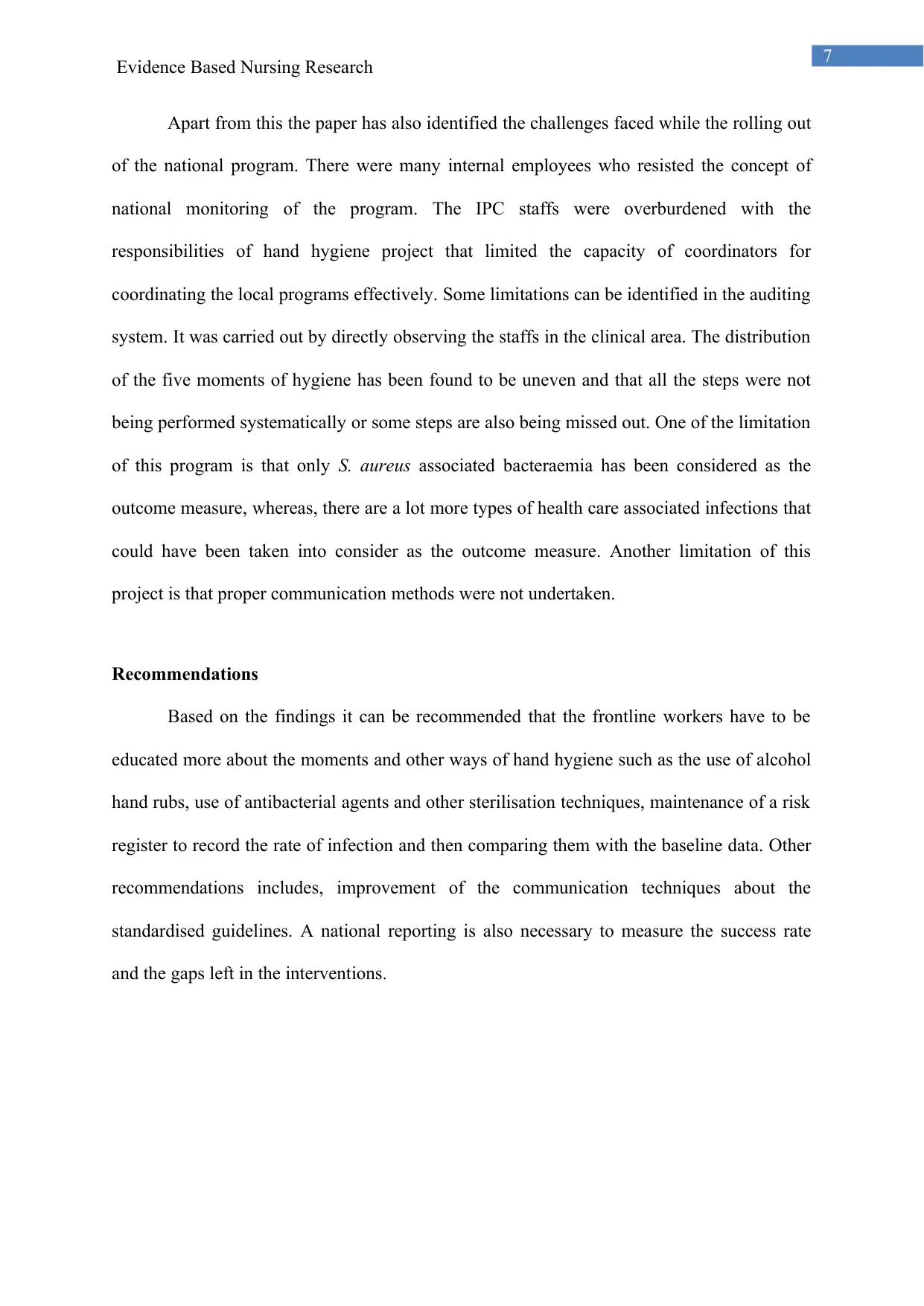
7
Evidence Based Nursing Research
Apart from this the paper has also identified the challenges faced while the rolling out
of the national program. There were many internal employees who resisted the concept of
national monitoring of the program. The IPC staffs were overburdened with the
responsibilities of hand hygiene project that limited the capacity of coordinators for
coordinating the local programs effectively. Some limitations can be identified in the auditing
system. It was carried out by directly observing the staffs in the clinical area. The distribution
of the five moments of hygiene has been found to be uneven and that all the steps were not
being performed systematically or some steps are also being missed out. One of the limitation
of this program is that only S. aureus associated bacteraemia has been considered as the
outcome measure, whereas, there are a lot more types of health care associated infections that
could have been taken into consider as the outcome measure. Another limitation of this
project is that proper communication methods were not undertaken.
Recommendations
Based on the findings it can be recommended that the frontline workers have to be
educated more about the moments and other ways of hand hygiene such as the use of alcohol
hand rubs, use of antibacterial agents and other sterilisation techniques, maintenance of a risk
register to record the rate of infection and then comparing them with the baseline data. Other
recommendations includes, improvement of the communication techniques about the
standardised guidelines. A national reporting is also necessary to measure the success rate
and the gaps left in the interventions.
Evidence Based Nursing Research
Apart from this the paper has also identified the challenges faced while the rolling out
of the national program. There were many internal employees who resisted the concept of
national monitoring of the program. The IPC staffs were overburdened with the
responsibilities of hand hygiene project that limited the capacity of coordinators for
coordinating the local programs effectively. Some limitations can be identified in the auditing
system. It was carried out by directly observing the staffs in the clinical area. The distribution
of the five moments of hygiene has been found to be uneven and that all the steps were not
being performed systematically or some steps are also being missed out. One of the limitation
of this program is that only S. aureus associated bacteraemia has been considered as the
outcome measure, whereas, there are a lot more types of health care associated infections that
could have been taken into consider as the outcome measure. Another limitation of this
project is that proper communication methods were not undertaken.
Recommendations
Based on the findings it can be recommended that the frontline workers have to be
educated more about the moments and other ways of hand hygiene such as the use of alcohol
hand rubs, use of antibacterial agents and other sterilisation techniques, maintenance of a risk
register to record the rate of infection and then comparing them with the baseline data. Other
recommendations includes, improvement of the communication techniques about the
standardised guidelines. A national reporting is also necessary to measure the success rate
and the gaps left in the interventions.
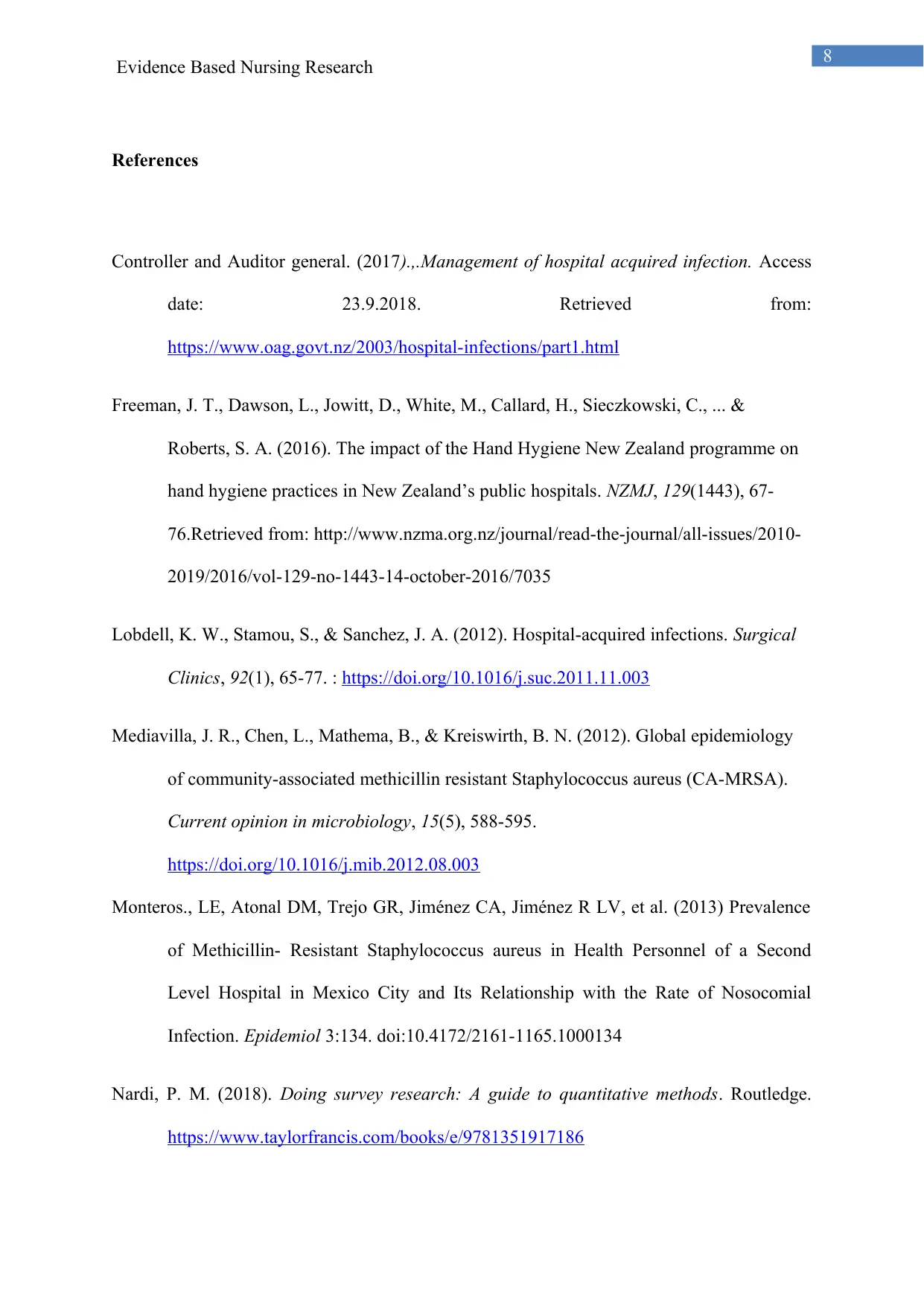
8
Evidence Based Nursing Research
References
Controller and Auditor general. (2017).,.Management of hospital acquired infection. Access
date: 23.9.2018. Retrieved from:
https://www.oag.govt.nz/2003/hospital-infections/part1.html
Freeman, J. T., Dawson, L., Jowitt, D., White, M., Callard, H., Sieczkowski, C., ... &
Roberts, S. A. (2016). The impact of the Hand Hygiene New Zealand programme on
hand hygiene practices in New Zealand’s public hospitals. NZMJ, 129(1443), 67-
76.Retrieved from: http://www.nzma.org.nz/journal/read-the-journal/all-issues/2010-
2019/2016/vol-129-no-1443-14-october-2016/7035
Lobdell, K. W., Stamou, S., & Sanchez, J. A. (2012). Hospital-acquired infections. Surgical
Clinics, 92(1), 65-77. : https://doi.org/10.1016/j.suc.2011.11.003
Mediavilla, J. R., Chen, L., Mathema, B., & Kreiswirth, B. N. (2012). Global epidemiology
of community-associated methicillin resistant Staphylococcus aureus (CA-MRSA).
Current opinion in microbiology, 15(5), 588-595.
https://doi.org/10.1016/j.mib.2012.08.003
Monteros., LE, Atonal DM, Trejo GR, Jiménez CA, Jiménez R LV, et al. (2013) Prevalence
of Methicillin- Resistant Staphylococcus aureus in Health Personnel of a Second
Level Hospital in Mexico City and Its Relationship with the Rate of Nosocomial
Infection. Epidemiol 3:134. doi:10.4172/2161-1165.1000134
Nardi, P. M. (2018). Doing survey research: A guide to quantitative methods. Routledge.
https://www.taylorfrancis.com/books/e/9781351917186
Evidence Based Nursing Research
References
Controller and Auditor general. (2017).,.Management of hospital acquired infection. Access
date: 23.9.2018. Retrieved from:
https://www.oag.govt.nz/2003/hospital-infections/part1.html
Freeman, J. T., Dawson, L., Jowitt, D., White, M., Callard, H., Sieczkowski, C., ... &
Roberts, S. A. (2016). The impact of the Hand Hygiene New Zealand programme on
hand hygiene practices in New Zealand’s public hospitals. NZMJ, 129(1443), 67-
76.Retrieved from: http://www.nzma.org.nz/journal/read-the-journal/all-issues/2010-
2019/2016/vol-129-no-1443-14-october-2016/7035
Lobdell, K. W., Stamou, S., & Sanchez, J. A. (2012). Hospital-acquired infections. Surgical
Clinics, 92(1), 65-77. : https://doi.org/10.1016/j.suc.2011.11.003
Mediavilla, J. R., Chen, L., Mathema, B., & Kreiswirth, B. N. (2012). Global epidemiology
of community-associated methicillin resistant Staphylococcus aureus (CA-MRSA).
Current opinion in microbiology, 15(5), 588-595.
https://doi.org/10.1016/j.mib.2012.08.003
Monteros., LE, Atonal DM, Trejo GR, Jiménez CA, Jiménez R LV, et al. (2013) Prevalence
of Methicillin- Resistant Staphylococcus aureus in Health Personnel of a Second
Level Hospital in Mexico City and Its Relationship with the Rate of Nosocomial
Infection. Epidemiol 3:134. doi:10.4172/2161-1165.1000134
Nardi, P. M. (2018). Doing survey research: A guide to quantitative methods. Routledge.
https://www.taylorfrancis.com/books/e/9781351917186
⊘ This is a preview!⊘
Do you want full access?
Subscribe today to unlock all pages.

Trusted by 1+ million students worldwide
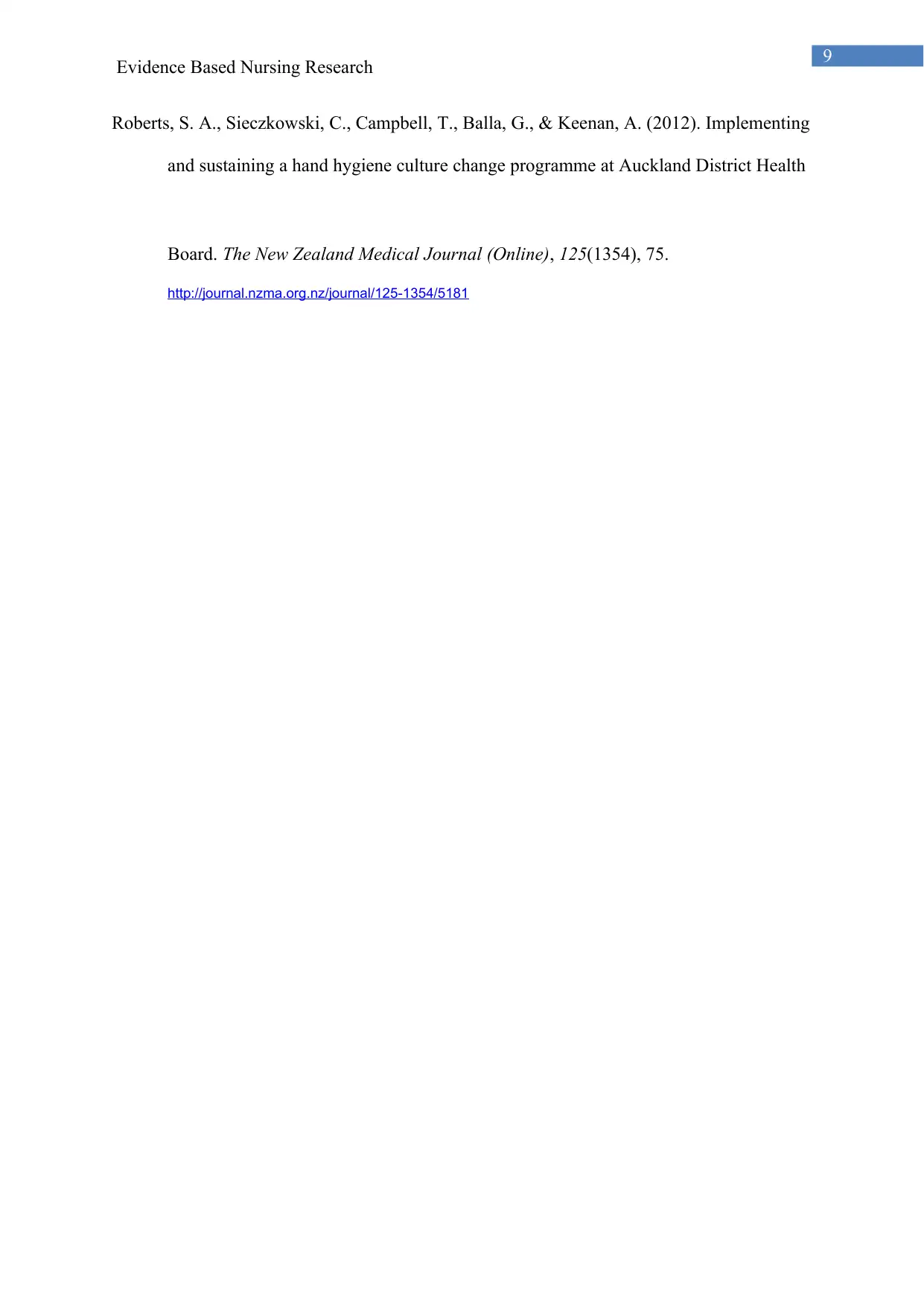
9
Evidence Based Nursing Research
Roberts, S. A., Sieczkowski, C., Campbell, T., Balla, G., & Keenan, A. (2012). Implementing
and sustaining a hand hygiene culture change programme at Auckland District Health
Board. The New Zealand Medical Journal (Online), 125(1354), 75.
http://journal.nzma.org.nz/journal/125-1354/5181
Evidence Based Nursing Research
Roberts, S. A., Sieczkowski, C., Campbell, T., Balla, G., & Keenan, A. (2012). Implementing
and sustaining a hand hygiene culture change programme at Auckland District Health
Board. The New Zealand Medical Journal (Online), 125(1354), 75.
http://journal.nzma.org.nz/journal/125-1354/5181
1 out of 10
Related Documents
Your All-in-One AI-Powered Toolkit for Academic Success.
+13062052269
info@desklib.com
Available 24*7 on WhatsApp / Email
![[object Object]](/_next/static/media/star-bottom.7253800d.svg)
Unlock your academic potential
Copyright © 2020–2025 A2Z Services. All Rights Reserved. Developed and managed by ZUCOL.



